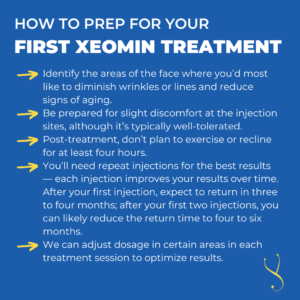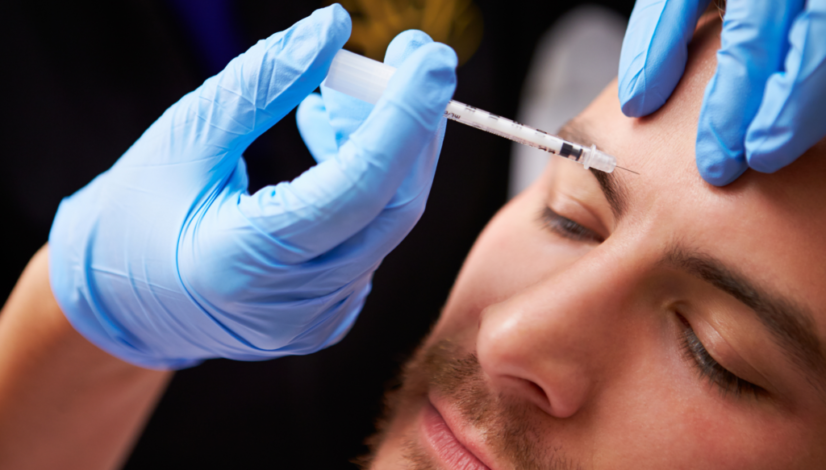Xeomin vs. Botox: How Do They Compare?
The world tells us not to judge a book by its cover, but that advice can be tough to follow when evaluating your own looks. As we age, we notice more lines and wrinkles, and how we feel about them affects our health and well-being.
Many patients who want to refresh an aging or fatigued appearance ask about Xeomin vs. Botox. Which one is best for reducing facial wrinkles and restoring self-confidence?
Self-Image and Health
Research suggests that how we perceive our own attractiveness has a direct impact on our psychological health. Our self-image shapes our overall mental health and how we interact with others.
The physicians at Signature Healthcare understand these feelings. We know that a positive self-image promotes a healthier relationship with oneself. We also know that self-criticism can cause emotional and mental distress and even affect physical health.
Because we spend more time with our patients than traditional practices do, we’re highly focused on preventive care. We take the time to learn about our patients’ self-image and identify solutions for potential issues.
In certain cases, cosmetic treatments such as Xeomin and Botox give patients a more positive self-view and outlook on life — and that’s beneficial for overall wellness!
Today’s Injectables: Xeomin vs. Botox
The popular aesthetic treatments Xeomin, Botox, and Dysport are FDA-tested, clinically proven purified proteins. Injected in small amounts directly into muscles around the eyes, mouth, forehead, and “marionette lines,” they block nerve impulses to those muscles, reducing wrinkles and frown lines for a more youthful look.
Unlike surgical procedures, injections are noninvasive. Because results diminish over time and require additional injections, patients can observe the effects of each injection and request fine-tuning at the injection point or in the amount of medication they receive.
How do we compare Xeomin to Botox? The two are small modifications of the same active ingredient, based on the same root protein.
But there are some notable differences:
Tolerance
A major advantage of Xeomin vs. Botox: Xeomin does not contain complex proteins, while Botox does.
The complex proteins in Botox may cause patients to develop antibodies against them. That means they could become “immune” to Botox’s effects after repeated use.
Effectiveness
In general, Xeomin takes effect faster — within a couple of days vs. three to five days for Botox. Also, in the case of neck lines, Xeomin has a slightly better “spread” than Botox (although less so than Dysport).
The effects of a Botox injection typically last about three months, sometimes longer. At Signature Healthcare, we prefer using Xeomin because the effects consistently last six months or more after an injection or two. The more treatments one receives, the better it works and the longer its effects last.
Dosing
Per the manufacturer’s instructions, average recommended doses differ between Xeomin and Botox for each area injected.
Both medications are also approved for other indications, with different injection patterns than cosmetic applications. Xeomin can treat unusually painful tightness in joints or muscles; Botox is often prescribed to treat neck spasms or migraine headaches.

What to Expect From a Xeomin Injection
Xeomin injections temporarily reduce the muscle activity that causes frown lines and wrinkles. Although it may not make you look like a 20-something again, you can smile, frown, or look surprised with fewer wrinkles and creases.
Here’s how to prepare for your first cosmetic treatment with Xeomin:
- Identify the areas of the face where you’d most like to diminish wrinkles or lines and reduce signs of aging.
- Be prepared for slight discomfort at the injection sites, although it’s typically well-tolerated.
- Post-treatment, don’t plan to exercise or recline for at least four hours.
- You’ll need repeat injections for the best results — each injection improves your results over time. After your first injection, expect to return in three to four months; after your first two injections, you can likely reduce the return time to four to six months or possibly even longer.
- We can adjust dosage in certain areas in each treatment session to optimize results.
Xeomin injections have few side effects — most commonly minimal bruising, swelling, or redness around the injection area, which resolve quickly. The occasional patient may feel a mild headache, which also resolves within a few hours.
In rare cases, a patient may experience an allergic reaction. Also rare, a patient who exercises within four hours of receiving their injection could inadvertently cause the medication to spread and affect the surrounding muscles (e.g., unwanted eyelid drooping).
A Good Self-Image Matters
At Signature Healthcare, we take the time to understand what you need, focus on your wellness, and help you avoid illness. When our patients feel good about themselves, that positive attitude benefits their longevity and well-being, too.
We recommend Xeomin vs. Botox as a non-surgical solution to reduce the effects of aging based on Xeomin’s effectiveness and ability to last six months or longer.
Get in touch with your Signature Healthcare physician. We’ll advise you on treatments to help you look and feel more youthful — and improve your all-important wellness outlook.


Dr. Jordan Lipton
Dr. Jordan Lipton, a distinguished physician with dual board certification in emergency and ambulatory medicine, co-founded Signature Healthcare and is renowned for his contributions to medical literature and international lectures. Balancing his professional achievements with personal interests, he enjoys squash, skiing, art, and cooking, alongside his wife, Dr. Siu Challons-Lipton, and their two grown children.

